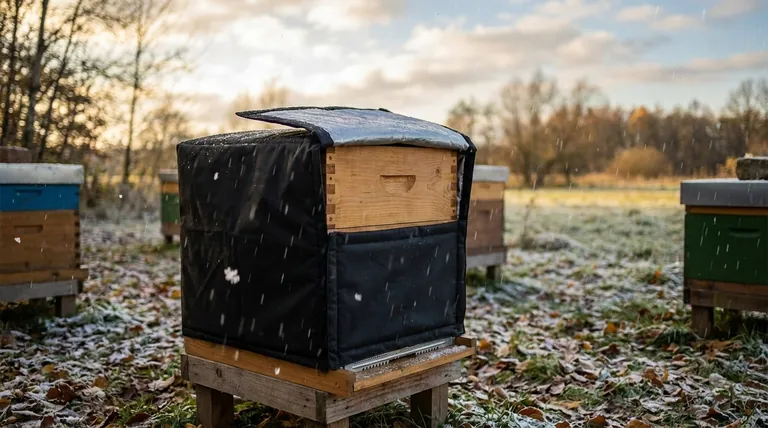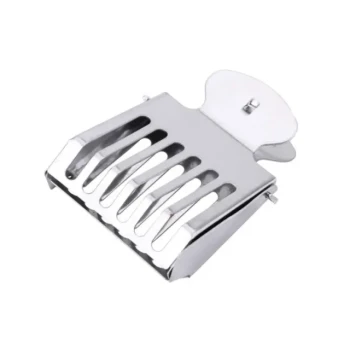The primary purpose of a beehive's top cover is to serve as the hive's first line of defense against the external environment. It functions as a protective roof, shielding the colony from rain, snow, and direct sun while also preventing pests from entering from above. Most modern designs are "telescoping," meaning they overhang the hive body to ensure water drips clear of the structure, preventing it from seeping into the hive.
While the top cover acts as the hive's weatherproof roof, its true function can only be understood in partnership with the inner cover. Together, they form a critical system for regulating temperature, managing moisture, and providing ventilation for the colony.

The Two-Part System: Top and Inner Covers
To understand the top cover, you must first understand that it does not work alone. It is the outer component of a two-part system designed to manage the hive's internal environment.
The Outer Cover: The Weatherproof Shell
The top cover, or outer cover, is the component you see on the very top of the hive. Its job is purely protective.
Its key function is to keep the inside of the hive completely dry and shielded. A "telescoping" top cover is the most common design because its edges hang down over the top hive box, creating a drip edge that channels water away.
The Inner Cover: The Climate Control Ceiling
The inner cover is a thin board that sits directly on top of the uppermost hive box, just beneath the outer cover. It is the more versatile and active component of the system.
A crucial function of the inner cover is to create a pocket of dead air space between it and the outer cover. This air gap provides significant insulation, helping keep the hive cooler in the summer and warmer in the winter.
The inner cover also prevents the bees from gluing the outer cover to the hive body with propolis (a resinous bee glue). This makes hive inspections far less disruptive to the colony.
Key Functions of the Integrated Cover System
When working together, the inner and outer covers provide several benefits that are critical for colony health and productivity.
Moisture and Condensation Management
Bees produce a significant amount of water vapor through respiration. In cold weather, this warm, moist air can rise, hit the cold outer cover, and condense into water that drips back down onto the bees, which can be lethal.
The inner cover's central hole allows this moist air to vent into the dead air space, where it can escape the hive without causing condensation directly above the cluster.
Providing a Secondary Entrance
Many inner covers have a small notch or opening on one edge. When oriented correctly, this creates a top entrance for the bees.
This secondary entrance reduces traffic congestion at the main bottom entrance, especially during a heavy nectar flow. It also provides an exit that is unlikely to be blocked by snow in the winter.
Temperature Regulation
The insulating air gap created between the inner and outer cover is essential for thermoregulation. It acts like the space in a double-pane window.
In the summer, it buffers the hive from the intense heat of the sun hitting the outer cover. In the winter, it reduces the amount of heat the colony loses through the top of the hive.
Understanding the Design Trade-offs
While the telescoping top cover and inner cover combination is standard, there are variations and potential issues to be aware of.
Telescoping vs. Migratory Covers
The standard telescoping cover offers maximum protection from the elements. However, commercial beekeepers often use a simpler, flat migratory cover.
Migratory covers sit flush with the hive body, making them easier to stack and transport on pallets. The trade-off is significantly less weather protection compared to a telescoping design.
The "Stuck Lid" Problem
If you operate a hive without an inner cover, the bees will invariably glue the top cover directly to the frames with propolis.
Attempting to remove a stuck lid requires significant force, which jolts the hive, angers the bees, and can damage frames and comb. The inner cover is the simple solution to this common problem.
Ventilation Choices
Using the top entrance provided by the inner cover is a trade-off. It improves summer ventilation and reduces congestion.
However, in a cold winter climate, this extra opening can create an undesirable draft. Beekeepers must decide whether to close this upper entrance based on their local climate and colony needs.
Making the Right Choice for Your Goal
Your choice of hive cover setup should align with your specific beekeeping objectives and environment.
- If your primary focus is maximum protection and colony health: Use the standard system of a telescoping top cover paired with an inner cover for superior weather defense and insulation.
- If your primary focus is commercial efficiency and transport: A simple, flat migratory cover is the industry standard, but be aware of its reduced protection from the elements.
- If your primary focus is managing high heat or humidity: Ensure you are utilizing the ventilation features of your inner cover, such as the central hole and the optional top entrance.
Ultimately, viewing the hive cover not as a single piece but as an integrated environmental system is the key to a healthier, more resilient colony.
Summary Table:
| Function | Outer Cover (Top Cover) | Inner Cover |
|---|---|---|
| Primary Role | Weatherproof shell | Climate control ceiling |
| Weather Protection | Shields from rain, snow, sun | Creates insulating dead air space |
| Moisture Management | Channels water away from hive | Vents moisture to prevent condensation |
| Ventilation/Entrance | - | Provides optional top entrance |
| Beekeeper Benefit | Maximum weather defense | Prevents 'stuck lid' problem; easier inspections |
Equip your apiary with the right protection from the top down. The correct hive cover system is fundamental to colony health and productivity. At HONESTBEE, we supply commercial apiaries and beekeeping equipment distributors with durable, high-performance telescoping top covers, inner covers, and migratory covers designed for maximum protection and efficiency. Let our wholesale-focused expertise help you choose the best setup for your operational goals and local climate.
Contact HONESTBEE today to discuss your hive cover needs and browse our full catalog of beekeeping supplies.
Visual Guide

Related Products
- Professional Insulated Winter Hive Wrap for Beekeeping
- Long Langstroth Style Horizontal Top Bar Hive for Wholesale
- Wholesales Dadant Size Wooden Bee Hives for Beekeeping
- Stainless Steel Beekeeping Honey Extractor Lid
- Inner Beehive Cover for Beekeeping Bee Hive Inner Cover
People Also Ask
- What are the durability features of Bee Blankets? Built to Last in Demanding Apiary Conditions
- What is the advantage of an insulated outer cover? Boost Winter Survival & Spring Buildup
- Should bee hives be insulated? Protect Your Colony from Moisture, Not Just Cold
- Is it always necessary to insulate beehives? A Guide to Winter Survival & Colony Health
- Why is insulation important for hives during winter? Ensure Your Bees Survive and Thrive



















